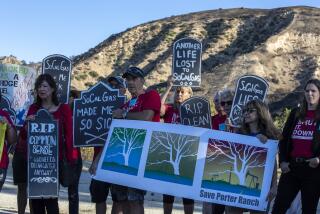California May Need Own Emergency Oil Reserve, Report Says
- Share via
California’s energy watchdogs, worried about whether the state would benefit fully from the nation’s 530-million-barrel Strategic Petroleum Reserve in case of an oil cutoff, are pondering the notion of a separate petroleum reserve for the West Coast.
Though some students of the oil industry think California might be better off than the rest of the country if oil supplies from the Middle East are interrupted, a draft report pending before the California Energy Commission says otherwise.
The report calls for investigating the prospects for a backyard petroleum reserve because of the West’s relative isolation from the oil pipeline system connecting the Louisiana-based Strategic Petroleum Reserve with the rest of the country.
The proposal is far from becoming policy, and there are those who think that California’s energy supplies are threatened more by earthquakes than by hostilities in the Middle East. But the issue reflects a long-standing concern in California and other Western states over how they would fare in a worldwide energy crisis.
Except for a pipeline now being built to send crude oil from California to Texas, the Western states aren’t connected by pipeline to the rest of the country. They get most of their oil from California and Alaska.
If an emergency dried up oil supplies on world markets, crude from the underground salt domes in Louisiana and Texas holding the federally controlled strategic reserves would have to be sent here by oceangoing tanker.
“Concerns have been raised that during a supply disruption, oil from the SPR might not reach the West Coast soon enough to mitigate a price run-up,” says the report. “A regional SPR may be needed for the Western United States.”
It is one of several recommendations by a committee of the Energy Commission, an advisory body. If the commission adopts the biennial fuels report, it would be submitted to the Legislature and the governor and money would be requested to pay for a study.
Manual Alvarez, adviser to Richard A. Bilas, one of two commissioners who made the recommendation, said a study would explore how much oil would be needed, what it would cost, who would pay for it, where the oil would be stored and under what conditions it should be tapped.
“There are a lot of unknowns,” said Alvarez.
The federal government has spent about $18 billion since 1977 to establish the SPR and fill the caverns at five sites with crude oil, where they sit awaiting an energy crisis.
Alvarez said the chief concern for California is how oil might be allocated around the country in case of an emergency. Alaskan oil, for instance, might be diverted by government fiat to Gulf Coast ports to alleviate a regional shortage, creating problems here.
However, the Reagan Administration says it won’t interfere directly in oil markets in such cases. Instead, it proposes to offer SPR oil to the highest bidders to increase the volumes of crude available, thus relieving the upward pressure on prices that would normally result from a cutoff of supplies.
If free markets were allowed to work that way in an emergency, California would probably continue to use its own oil and that from Alaska’s North Slope, said Philip K. Verlager, energy economist at the Institute for International Economics in Washington, who has studied the Strategic Petroleum Reserve.
“In that case, I think the state of California would be better off than the rest of the country,” Verlager said.
An Energy Department spokeswoman said the idea of regional petroleum reserves has been explored before. But she said the task of coordinating the release of oil from regional reserves with that from the national oil stockpile and those in Germany, Japan and other countries under international agreements has been found to be almost hopelessly complicated.
More to Read
Sign up for Essential California
The most important California stories and recommendations in your inbox every morning.
You may occasionally receive promotional content from the Los Angeles Times.













